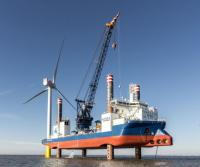
The International Marine Contractors Association and the National Workboat Association have agreed new guidelines on the optimum design and configuration of boat landings for accessing wind turbine foundations from crew transfer vessels. The wide ranging document includes sections on crew transfer to offshore wind turbines; the questionnaire; data analysis; fender impact loading, safe clearances; as well as the executive summary, introduction, conclusion and recommendations. IMCA is the international association representing offshore, marine and underwater engineering companies. The International Marine Contractors Association’s Renewable Energy Workgroup had identified this as one of the areas where there could be benefits, both in terms of cost reduction and safety improvement for marine operations for renewable energy. Richard Benzie, IMCA Technical Director, explained: “In order to undertake this task, a questionnaire was issued to all the operators of European offshore wind farms to gather information on existing boat landing geometries. At the same time, feedback was sought on the experience of CTV operators, fender manufacturers and structure designers. “A significant volume of data and feedback was gathered. On analysis of the data it has been possible to develop a recommended geometry for a standard boat landing that is consistent with the G Global Offshore Wind Health & Safety Organisation (formerly G9) guidelines. “One critical area where data was lacking was on the design impact forces for the boat landing This information was not as readily available as expected, with only two out of twenty-four projects originally being able to supply it. Looking in detail at how the design codes address impact loads, a number of areas of challenge and further research have been identified. “Based on the feedback, several other potential areas for research have been identified in our extensive document. It is now recommended that these are taken up by the relevant research bodies.” Companies and organisations which took part in the research included Centrica Energy; DONG Energy; E.ON; SSE, Statoil, Statkraft, Scottish Power, RWE, Vattenfall and the Energy Institute. (Source: Scottisch Energy)
![[ad-side]](http://www.crewing24.com/ad_images/106_banner.jpg)
![[ad-side]](http://www.crewing24.com/ad_images/103_banner.jpg)
![[ad-side]](http://www.crewing24.com/ad_images/93_banner.jpg)
![[ad-side]](http://www.crewing24.com/ad_images/107_banner.jpg)
![[ad-side]](http://www.crewing24.com/ad_images/88_banner.jpg)
![[ad-side]](http://www.crewing24.com/ad_images/82_banner.jpg)
![[ad-side]](http://www.crewing24.com/ad_images/95_banner.gif)
![[ad-side]](http://www.crewing24.com/ad_images/89_banner.png)
![[ad-side]](http://www.crewing24.com/ad_images/87_banner.png)